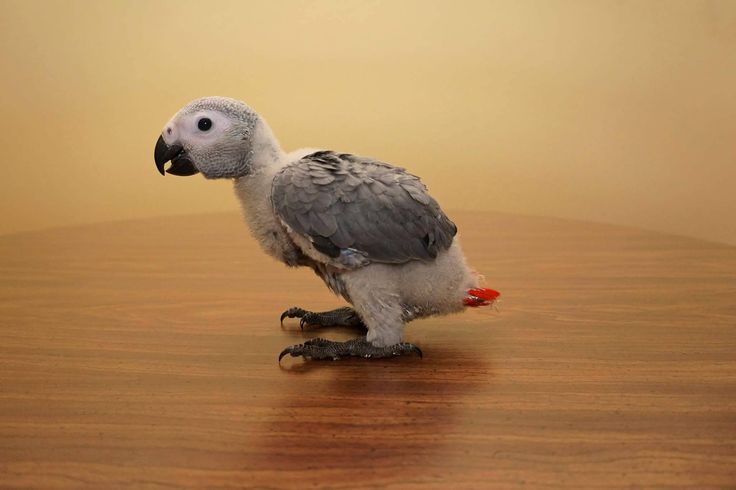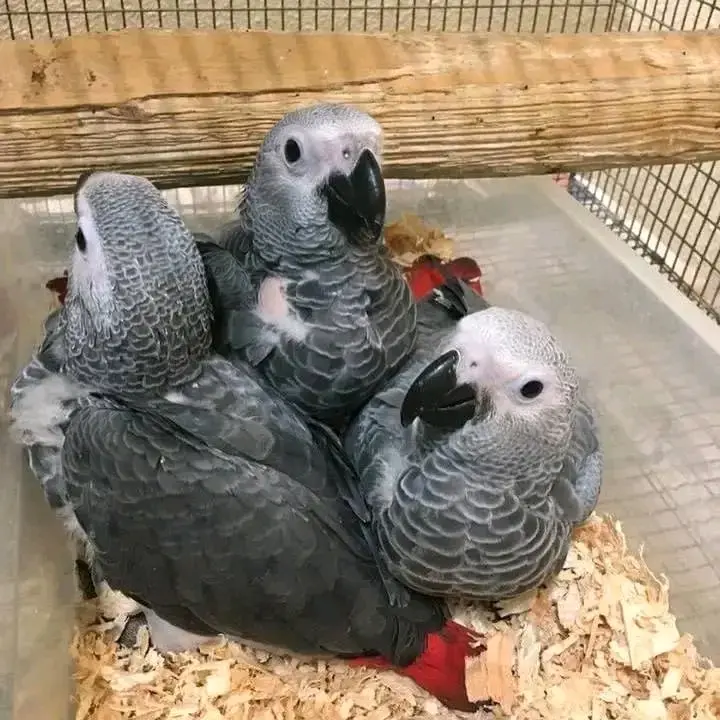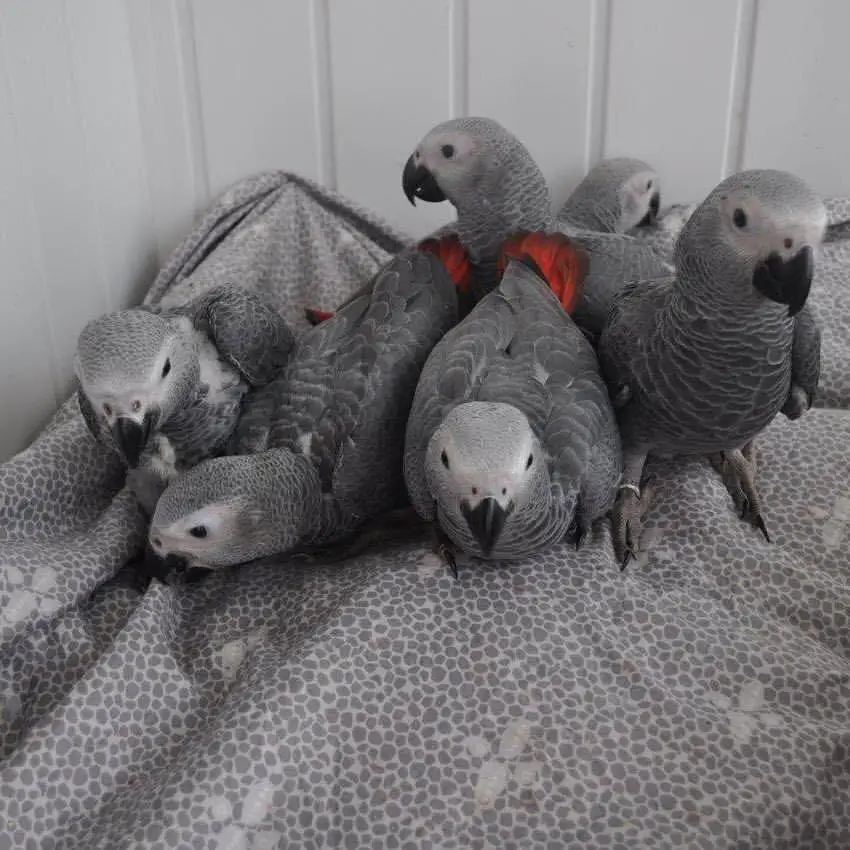Avian Articles, Blogs
Baby African Grey Parrot for Sale – Top Breeders & Prices
Looking to add a new member to your family? A baby African Grey parrot might be a great choice.
Imagine the joy of coming home to a parrot waiting to greet you. It will delight you with its fun nature and ability to talk. African Grey parrots are not only smart but make strong connections with their owners.
Finding the right baby African Grey is crucial. Look for a breeder who raises them in a healthy and friendly environment. We have all the vital info on finding and caring for these amazing birds.
Are you curious about where to get a baby African Grey, and how much they cost? We’ll guide you through finding a trustworthy breeder. This way, you can pick the ideal parrot for your family.
- Learn about the two species of African Grey parrots: the Psittacus erithacus (Congo African Grey) and the Psittacus timneh (Timneh African Grey).
- Discover the unique traits of Congo and Timneh African Greys. This includes their size, weight, and wingspan.
- Find out about their lifespan and any health concerns. Knowing these will help you care for your parrot better.
- Learn about African Greys’ amazing intelligence and talking skills.
- Know that Timneh African Greys learn to talk faster than Congo African Greys.
- See the prices of baby African Grey parrots from trusted sellers. We will discuss what affects the cost.
- Learn about extra costs, like identifying the parrot’s gender.
- Discover why it’s important to check the parrot with a vet before buying it.
- Get advice on picking a baby African Grey that’s healthy and has a good temperament.
This guide will help you find a reliable breeder and welcome your new parrot home. Your journey with a baby African Grey parrot is about to begin. Enjoy every moment!
Understanding the African Grey Parrot Species
African Grey parrots are known for their smart minds and mimicking human speech. They are part of the African Grey Parrot species with the Congo African Grey and the Timneh African Grey types. Congo African Greys come from Central Africa, but Timneh African Greys live in Western Africa. These birds have unique features that make them easily identifiable.
Distinct Features of Congo and Timneh African Greys
Congo African Greys stand out with their red tails and black beaks. Timneh African Greys have maroon tails and lighter grey upper beaks. These differences help us tell the two types apart.
Dietary Needs for Optimal Health
Keeping African Grey parrots healthy starts with a good diet. They should eat high-quality pellets and various fruits and veggies. This includes pomegranates, organic mangoes, and melons. They can also enjoy seeds like hemp and flaxseed for extra nutrition. Treats like nuts and green beans are good for them too.
Natural Habitat and Conservation Status
African Grey parrots love the rainforests of Central and West Africa. But, their homes are disappearing due to trade and habitat loss. This is why we need to protect them It’s important to support conservation to save these amazing birds and their habitats.
African Grey Parrots can live up to 60 years. They need a lot of human interaction and time outside their cages to be happy. Without enough people around, they can start plucking their feathers, get too loud, or show other bad behaviors. They can even hurt themselves or feel sad because they’re alone.
Keep in mind, that they get very noisy, especially in the morning and evening. They often screech loud sounds. After about a year, they may start talking and copying noises they hear. But not all of them will learn to talk much. This might not be good if you live in an apartment or have very sensitive neighbors. Think about who could be bothered by the noise before getting a parrot.
Finding Reputable African Grey Parrot Breeders
If you’re looking to bring an African Grey parrot into your home, finding a good breeder is crucial. This ensures your new parrot is healthy and well taken care of.
Start your search at Parrots of the World in Rockville Center, LI. They have baby African Grey Parrots for sale at $1500. Their solid reputation makes them a trustworthy place to buy a baby African Grey Parrot.
Congo African Grey (CAG) parrot prices can vary from $1000 to $1200 in certain places. When looking for a CAG, seek out prices within this range for a fair deal.
Interested in Timneh African Grey (TAG) parrots? You’ll find prices are usually between $800 to $899. This price level serves as a guide for your TAG parrot search.
Remember, small breeders may be slow to react to market changes. If you’re looking at a smaller breeder, keep this in consideration.
Handfed, weaned African Greys are often priced at $1000. This indicates that these birds are taken care of properly.
On top of the base price, expect to pay $25-$50 for sexing baby parrots. This is a normal charge to determine the parrot’s gender.
Never pay for a bird before seeing it in person from a reputable breeder. This way, you ensure your parrot is a good fit for your family.
It’s also good to see the baby parrot’s living conditions and the cleanliness of their environment. This step is critical in ensuring the parrot comes from a caring place.
Finding a good African Grey parrot breeder necessitates thorough research. Look for breeders praised for their care and focus on parrot health. Putting in this effort will lead you to a trustworthy source and a joyful new family member.
Why Choose a Baby African Grey Parrot as Your Pet
Baby African Grey parrots make great pets. They are smart, talkative, and very loving. This makes them a hit with bird lovers.
One top reason for picking a baby African Grey parrot is how long they live. These parrots can be with you for 30 to 50 years. So, they can be a constant part of your family for many years.
What’s more, baby African Grey parrots are super smart. They can pick up hundreds of words and build a big vocabulary. This makes them not just fun friends but excellent talkers too.
African Grey parrots also make strong connections with their favorite person. They will choose one in your family to be especially close with. This special bond makes both the parrot and the owner truly happy.
Choosing a baby African Grey parrot brings joy and activity to your home. They love chatting, music, TV, and games. Their love for fun and games brightens up your daily life.
But, keeping an African Grey parrot happy is also a big job. They need lots of mental and physical activities. It’s vital to meet their needs to prevent problems like destructive behavior.
There are challenges to owning a baby African Grey parrot. Their smarts and needs can be tough for first-time bird owners. It’s key to study, learn, and get ready to care for them well.
According to statistics from the American Veterinary Medical Foundation, there were only 114 board-certified avian veterinarians in the US in 2016.
In short, a baby African Grey parrot is a wonderful pet choice. They bring long years of companionship, brains, and a loving heart. Yet, it’s essential to know how to care for them to ensure they thrive.
Prices and What Influences the Cost of a Baby African Grey
Thinking about getting a baby African Grey parrot? Know what makes their prices vary. Their cost is affected by where you buy them, the kind they are, and the costs of looking after them.
As Link 1 shows, an African Grey Parrot can cost anywhere from £1200 to £2800. This depends on if you get it from a breeder or a store, and if it’s a Congo or Timneh African Grey.
Buying the parrot is just the start. You also need to think about the extra costs. This includes getting them the right toys and perches for play, a big cage, and a healthy diet of seeds, pellets, veggies, and fruit. They also need regular health checks, which add to the total cost.
Many things can make an African Grey Parrot cost more. The bird’s age, the way it looks, and where you buy it from all matter. Breeders’ practices and their location can influence the price too. For instance, getting one from Africa might be cheaper than from America because of additional costs like shipping.
African Grey Parrots are special for their smartness, ability to talk like humans, and unique needs, which makes them more expensive. This is why they’re a favorite among people who love birds.
In conclusion, the price of a baby African Grey is influenced by many factors. It’s crucial to look at both the buying cost and the costs of caring for them. Finding a good seller and understanding these influencers can help you get a great baby African Grey.
Baby African Grey Parrot for Sale – Selection and Care Tips
Getting a baby African Grey parrot means making your home safe for them. You must learn how to meet their unique needs. This will make your baby parrot feel at home. Here are tips for choosing and taking care of your new parrot:
Preparing Your Home for a Baby African Grey
Make sure your home is safe before you bring your baby African Grey parrot home. Check for toxic plants or things that could hurt the parrot. Also, keep windows and doors safe from escapes with screens or special curtains.
African Greys are smart and curious, so you need to bird-proof your home. Cover electric cords and hide anything that might be dangerous to them. They love toys and perches, but make sure these are bird safe. Keep harmful chemicals away from them too.
Essential Supplies for Your New Feathered Friend
There’s a list of things you’ll need for your African Grey parrot:
- A big cage that fits their size, with the right space between bars
- Healthy bird food like pellets, fruits, and veggies
- Dishes for water and food that you can clean easily
- Lots of toys and perches for fun and exercise
- A way for them to take baths
- A first aid kit approved by a vet
Long-Term Commitment: Understanding the Lifespan of African Greys
Thinking about a baby African Grey parrot means knowing it’s a long-term job. They can live 25 to 50 years or even more, depending on care. It takes a dedicated and patient person to care for them their whole life.
Owning an African Grey parrot is a serious duty. They love company, need mental challenges, good food, and regular exercise. This keeps them healthy and happy. If you’re ready for such a commitment, they make wonderful companions.
To end, picking and raising a baby African Grey parrot takes thought and work. Ensure a safe, fun space, get the needed supplies, and know about their long life. This way, your parrot and you will have a happy time together.
Conclusion
A baby African Grey parrot can fill your home with joy. Their intelligence is truly remarkable. They are loving and can speak like humans. If you’re thinking about getting one, this article has all you need to know. It will help you pick a good breeder or seller. Also, you’ll learn about different species and their needs. This will help you make a smart choice for your new pet.
Baby African Grey parrots need a big and fun place to live. A diet of top-quality pellets and fresh food is key for their health. They must have enough room to fly and play. Without this, they might get too heavy and not be happy. They love company and exploring new things, like toys. You should also trim their nails sometimes to keep them from getting hurt. When you train them, use kindness and keep at it. They respond best to this.
Think carefully before you get an African Grey parrot. They need a lot of your time and attention. These parrots are very popular pets worldwide. It’s wise to look into prices first to make sure you’re paying a fair amount. Sometimes, adopting is a more affordable choice compared to buying from a breeder. Remember, they come with extra costs for health checks, cages, and toys. Choose a seller with good reviews. Low prices can mean the parrot’s health or living conditions are not good.
FAQ
Where can I buy a baby African Grey parrot?
How much does a baby African Grey parrot cost?
Where can I buy a baby African Grey parrot?
How much does a baby African Grey parrot cost?
FAQ
Where can I buy a baby African Grey parrot?
You can find baby African Grey parrots from several sources. Check with reputable breeders, specialized bird pet stores, or online sellers.
How much does a baby African Grey parrot cost?
The cost of a baby African Grey varies. It depends on age, color mutation, and breeder reputation. Typically, they range from
FAQ
Where can I buy a baby African Grey parrot?
You can find baby African Grey parrots from several sources. Check with reputable breeders, specialized bird pet stores, or online sellers.
How much does a baby African Grey parrot cost?
The cost of a baby African Grey varies. It depends on age, color mutation, and breeder reputation. Typically, they range from $1,200 to $3,000.
What are the distinct features of Congo and Timneh African Grey parrots?
Congo Greys are bigger with bright red tails. Timneh Greys are smaller, with a dark charcoal beak and plumage.
What do I need to know about the dietary needs of African Grey parrots?
African Grey parrots need a varied diet. Offer them high-quality pellets, fresh fruits, vegetables, nuts, and seeds for their nutritional needs.
What is the natural habitat of African Grey parrots, and what is their conservation status?
They come from West and Central African rainforests. Unfortunately, they face threats like habitat loss and trapping, making them vulnerable.
How can I find reputable African Grey parrot breeders, hatcheries, and sellers?
To find a good breeder, research and visit them if you can. Ask for customer references. You can also get advice from avian vets or bird clubs.
What are the benefits of choosing a baby African Grey parrot as a pet?
Baby African Greys are smart and can learn to talk. They bond strongly with their human family. Plus, they enjoy socializing and mental challenges.
What factors influence the cost of a baby African Grey parrot?
A parrot’s age, color mutation, and breeder reputation affect its price. Rare colors and respected breeders may cost more.
How do I select a healthy and well-behaved baby African Grey parrot?
Choose a parrot with bright eyes, clean feathers, and who is active. They should also be curious, lively, and responsive.
What do I need to do to prepare my home for a baby African Grey parrot?
Get your home ready by making it safe and interesting for your new parrot. Remove harmful plants, secure all openings, and add toys and perches.
How long do African Grey parrots live, and what does their long-term commitment entail?
African Greys can live for over 50 years. Caring for them means providing a balanced diet, regular vet visits, and plenty of mental challenges and social time.
,200 to ,000.
What are the distinct features of Congo and Timneh African Grey parrots?
Congo Greys are bigger with bright red tails. Timneh Greys are smaller, with a dark charcoal beak and plumage.
What do I need to know about the dietary needs of African Grey parrots?
African Grey parrots need a varied diet. Offer them high-quality pellets, fresh fruits, vegetables, nuts, and seeds for their nutritional needs.
What is the natural habitat of African Grey parrots, and what is their conservation status?
They come from West and Central African rainforests. Unfortunately, they face threats like habitat loss and trapping, making them vulnerable.
How can I find reputable African Grey parrot breeders, hatcheries, and sellers?
To find a good breeder, research and visit them if you can. Ask for customer references. You can also get advice from avian vets or bird clubs.
What are the benefits of choosing a baby African Grey parrot as a pet?
Baby African Greys are smart and can learn to talk. They bond strongly with their human family. Plus, they enjoy socializing and mental challenges.
What factors influence the cost of a baby African Grey parrot?
A parrot’s age, color mutation, and breeder reputation affect its price. Rare colors and respected breeders may cost more.
How do I select a healthy and well-behaved baby African Grey parrot?
Choose a parrot with bright eyes, clean feathers, and who is active. They should also be curious, lively, and responsive.
What do I need to do to prepare my home for a baby African Grey parrot?
Get your home ready by making it safe and interesting for your new parrot. Remove harmful plants, secure all openings, and add toys and perches.
How long do African Grey parrots live, and what does their long-term commitment entail?
African Greys can live for over 50 years. Caring for them means providing a balanced diet, regular vet visits, and plenty of mental challenges and social time.



